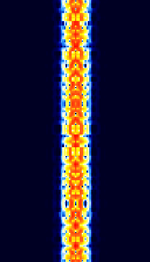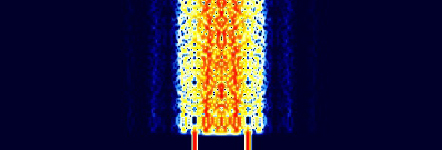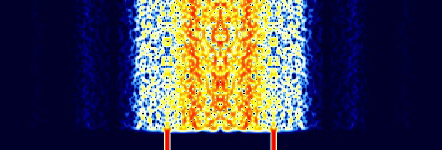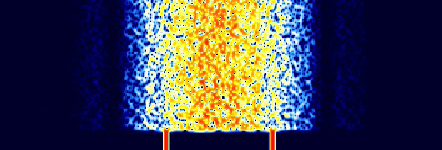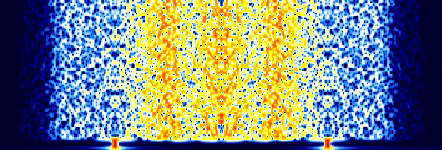Phase Shift Keying (PSK)
PSKPhase-Shift Keying is a digital amateur radio mode based on Phase-Shift Keying (PSKPhase-Shift Keying) modulation. Most commonly used in HFHigh Frequency (3-30 MHz), rarely seen at higher frequencies.
Modes and Samples[edit]
There are many different PSKPhase-Shift Keying modes. These modes are ones found available with the fldigi software. The most popular and commonly used mode is PSKPhase-Shift Keying 31 (developed by Peter G3PLX). Its narrow bandwidth and typing-speed baudBaud (unit symbol Bd) is the unit for symbol rate or modulation rate in symbols per second. rate make it popular for Ham Operators to use for keyboard to keyboard communications within the amateur bands.
PSKPhase-Shift Keying 63 (developed by Moe Wheatley (AE4JY) and Howard Teller (KH6TY)) is twice as fast as PSKPhase-Shift Keying 31, and occupies 160 HzHertz (Hz), unit of frequency, defined as one cycle per second (1 Hz). of bandwidth. These can occasionally be seen. PSKPhase-Shift Keying 63 FECForward Error Correction (developed by Nino Porcino IZ8BLY) is a variant of PSKPhase-Shift Keying 63 that uses convolutional encoding to provide forward error correction. It is more suitable in more noisy environments where the other PSKPhase-Shift Keying modes would have large error rates.
The other modes (PSKPhase-Shift Keying 125, 250, 500, 1000) are used for sending large text files or binary files. These have a far higher transfer rate. Due to the high rate of transfer, typically ARQAutomatic Repeat reQuestAutomatic Repeat Query (Automatic Repeat Request) is also applied when sending files via these modes to ensure that the recipient gets 100% of the file. When sending binary files, one missed bit can make a file completely worthless, so it's important that the recipient has a complete copy without any loss. PSKMail is a good example of using ARQAutomatic Repeat reQuestAutomatic Repeat Query and PSKPhase-Shift Keying to send files.
Within PSKPhase-Shift Keying, there are 2 primary modulation modes: Binary PSKPhase-Shift Keying (Also known as 2-PSKBinary Phase-Shift Keying (1 bit per symbol)) and Quadrature PSKPhase-Shift Keying (Also known as 4-PSKQuadrature Phase-Shift Keying (2 bits per symbol)). Binary PSKPhase-Shift Keying uses only 2 phase constellations to send characters, whereas Quadrature PSKPhase-Shift Keying uses 4 phase constellations.
| Binary PSKPhase-Shift Keying | Quadrature PSKPhase-Shift Keying |
|---|---|
| |
|
| |
|
| |
|
| |
|
| |
|
Other variants[edit]
| |
|
| |
|
| |
|
Frequencies[edit]
1.838 MHzMegaHertz (MHz) 10^6 Hz
3.580 MHzMegaHertz (MHz) 10^6 Hz
7.035 MHzMegaHertz (MHz) 10^6 Hz (Region 3)
7.040 MHzMegaHertz (MHz) 10^6 Hz (Regions 1,2)
10.142 MHzMegaHertz (MHz) 10^6 Hz
14.070 MHzMegaHertz (MHz) 10^6 Hz
18.100 MHzMegaHertz (MHz) 10^6 Hz
21.080 MHzMegaHertz (MHz) 10^6 Hz
24.920 MHzMegaHertz (MHz) 10^6 Hz
28.120 MHzMegaHertz (MHz) 10^6 Hz
50.290 MHzMegaHertz (MHz) 10^6 Hz
144.144 MHzMegaHertz (MHz) 10^6 Hz
222.07 MHzMegaHertz (MHz) 10^6 Hz
432.2 MHzMegaHertz (MHz) 10^6 Hz
909 MHzMegaHertz (MHz) 10^6 Hz
Decoding Software[edit]
- Hobby Level Software
- AndFLMsg for Android Devices
- Bonito RadioJet Deooder (in German)
- Fldigi
- MixW
- MultiMode Cocoa
- MultiPSK
- PSKmail
- TIVAR Android fork of FLDigi
- WinWarbler
- Professional Equipment/Software
Video Examples[edit]
Additional Links[edit]
- HF Digital "Tower of Babel"
- W1AW digital transmissions
- shoc Database: PSK31
- WAVECOM Database: PSK-31, PSK-63, PSK-125, PSK-250
- WAVECOM Database: PSK-10
- WAVECOM Database: PSK-31-FEC
- WAVECOM Database: PSK-63F, PSK-125F, PSK-220F
- PSK31 Spec
- PSK Modems fldigi manual
- fldigi manual mode
- PSK 63
- Phase-shift Keying Wikipedia
